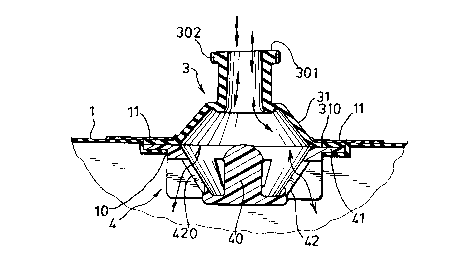Une partie des informations de ce site Web a été fournie par des sources externes. Le gouvernement du Canada n'assume aucune responsabilité concernant la précision, l'actualité ou la fiabilité des informations fournies par les sources externes. Les utilisateurs qui désirent employer cette information devraient consulter directement la source des informations. Le contenu fourni par les sources externes n'est pas assujetti aux exigences sur les langues officielles, la protection des renseignements personnels et l'accessibilité.
L'apparition de différences dans le texte et l'image des Revendications et de l'Abrégé dépend du moment auquel le document est publié. Les textes des Revendications et de l'Abrégé sont affichés :
| (12) Demande de brevet: | (11) CA 2238593 |
|---|---|
| (54) Titre français: | VALVE DE GONFLAGE |
| (54) Titre anglais: | INFLATING VALVE |
| Statut: | Réputée abandonnée et au-delà du délai pour le rétablissement - en attente de la réponse à l’avis de communication rejetée |
| (51) Classification internationale des brevets (CIB): |
|
|---|---|
| (72) Inventeurs : |
|
| (73) Titulaires : |
|
| (71) Demandeurs : |
|
| (74) Agent: | GOWLING WLG (CANADA) LLP |
| (74) Co-agent: | |
| (45) Délivré: | |
| (22) Date de dépôt: | 1998-05-22 |
| (41) Mise à la disponibilité du public: | 1998-11-30 |
| Requête d'examen: | 1998-05-22 |
| Licence disponible: | S.O. |
| Cédé au domaine public: | S.O. |
| (25) Langue des documents déposés: | Anglais |
| Traité de coopération en matière de brevets (PCT): | Non |
|---|
| (30) Données de priorité de la demande: | ||||||
|---|---|---|---|---|---|---|
|
Cette invention concerne une valve de gonflage formée d'une partie intérieure et d'une partie extérieure qui comportent un premier et un second rebords périphériques collés de part et d'autre de la paroi d'un objet à gonfler, et un bouchon et une busette tubulaire centrés adaptés pour être réunis de façon étanche. Une première cloison de forme tronconique formée entre le bouchon et le premier rebord périphérique comporte une série de trous de communication avec la busette tubulaire. Une deuxième cloison de forme tronconique formée entre la busette tubulaire et le second rebord périphérique de manière à pouvoir prendre appui contre le premier rebord peut être pliée à son extrémité de grand diamètre pour séparer la busette tubulaire du bouchon.
An inflating valve includes inner and outer pieces
which have first and second peripheral flanges for
cementing together and a central plug and a central
tubular spout to be sealingly fitted together. A
frusto-conical shaped first web portion is formed
between the plug and the first peripheral flange to
project inward from the first peripheral flange and is
provided with a plurality of passage holes for
communication with the tubular spout. A second web
portion of frusto-conical shape is formed between the
tubular spout and the second peripheral flange to abut
against the first peripheral flange and can be flexed
at its wider end so as to separate the tubular spout
from the plug.
Note : Les revendications sont présentées dans la langue officielle dans laquelle elles ont été soumises.
Note : Les descriptions sont présentées dans la langue officielle dans laquelle elles ont été soumises.

2024-08-01 : Dans le cadre de la transition vers les Brevets de nouvelle génération (BNG), la base de données sur les brevets canadiens (BDBC) contient désormais un Historique d'événement plus détaillé, qui reproduit le Journal des événements de notre nouvelle solution interne.
Veuillez noter que les événements débutant par « Inactive : » se réfèrent à des événements qui ne sont plus utilisés dans notre nouvelle solution interne.
Pour une meilleure compréhension de l'état de la demande ou brevet qui figure sur cette page, la rubrique Mise en garde , et les descriptions de Brevet , Historique d'événement , Taxes périodiques et Historique des paiements devraient être consultées.
| Description | Date |
|---|---|
| Inactive : Morte - Aucune rép. dem. par.30(2) Règles | 2001-08-20 |
| Demande non rétablie avant l'échéance | 2001-08-20 |
| Réputée abandonnée - omission de répondre à un avis sur les taxes pour le maintien en état | 2001-05-22 |
| Inactive : Abandon. - Aucune rép dem par.30(2) Règles | 2000-08-18 |
| Inactive : Dem. de l'examinateur par.30(2) Règles | 2000-02-18 |
| Demande publiée (accessible au public) | 1998-11-30 |
| Symbole de classement modifié | 1998-10-02 |
| Inactive : CIB attribuée | 1998-10-02 |
| Inactive : CIB en 1re position | 1998-10-02 |
| Inactive : CIB attribuée | 1998-10-02 |
| Exigences de dépôt - jugé conforme | 1998-08-05 |
| Inactive : Certificat de dépôt - RE (Anglais) | 1998-08-05 |
| Demande reçue - nationale ordinaire | 1998-08-04 |
| Toutes les exigences pour l'examen - jugée conforme | 1998-05-22 |
| Exigences pour une requête d'examen - jugée conforme | 1998-05-22 |
| Date d'abandonnement | Raison | Date de rétablissement |
|---|---|---|
| 2001-05-22 |
Le dernier paiement a été reçu le 2000-04-28
Avis : Si le paiement en totalité n'a pas été reçu au plus tard à la date indiquée, une taxe supplémentaire peut être imposée, soit une des taxes suivantes :
Veuillez vous référer à la page web des taxes sur les brevets de l'OPIC pour voir tous les montants actuels des taxes.
| Type de taxes | Anniversaire | Échéance | Date payée |
|---|---|---|---|
| Requête d'examen - petite | 1998-05-22 | ||
| Enregistrement d'un document | 1998-05-22 | ||
| Taxe pour le dépôt - petite | 1998-05-22 | ||
| TM (demande, 2e anniv.) - petite | 02 | 2000-05-22 | 2000-04-28 |
Les titulaires actuels et antérieures au dossier sont affichés en ordre alphabétique.
| Titulaires actuels au dossier |
|---|
| BULTON ENTERPRISES CO., LTD. |
| Titulaires antérieures au dossier |
|---|
| HSIN-PING WU |
| HSIN-TSAI WU |